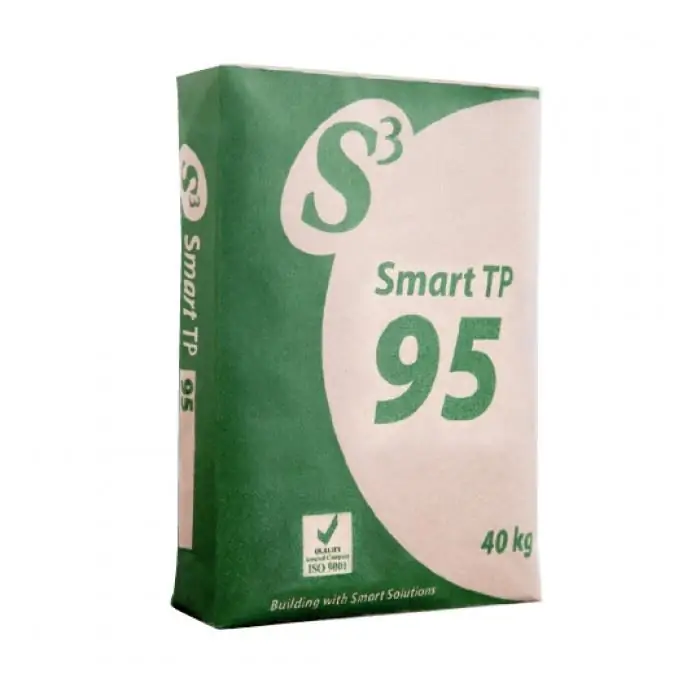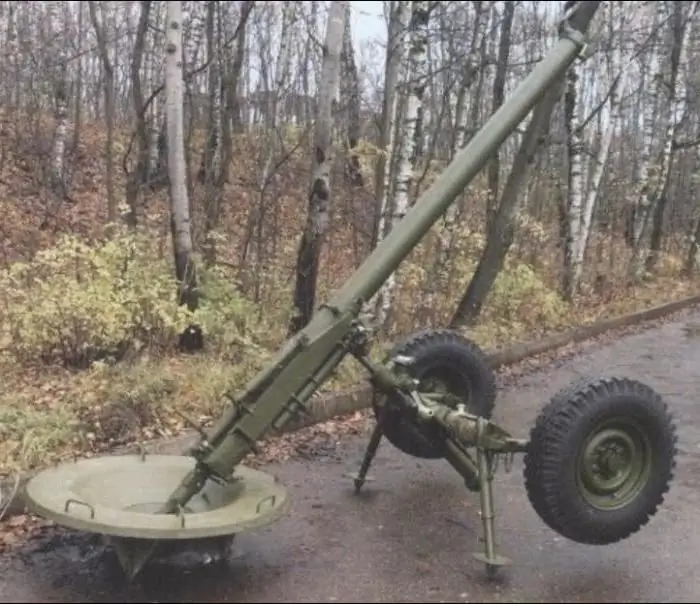2026 Author: Howard Calhoun | [email protected]. Last modified: 2025-01-24 13:10:43
Immediately after the Winter War of 1939, it finally became clear that there was a clear shortage of heavy mortars in the troops, which could be effectively used to destroy enemy fortified positions. The Great Patriotic War prevented the start of work on their creation, when the Soviet industry was not up to heavy mortars.
After the Victory, work resumed. Initially, the M-240 installation was created. Its caliber, as the name implies, was 240 mm. But the characteristics of the machine did not fully satisfy the military. In particular, they were unhappy with the extremely weak armor. In addition, there were claims to the chassis. It was at this time that the development of the Tulip installation began. This self-propelled gun was supposed to have increased power, heavier armor and a reliable undercarriage.

Begin development
The work was started on July 4, 1967, in accordance with Decree No. 609-20. As for the most important, artillery part of the new gun (it took placeunder the index 2B8), it was taken almost unchanged from the heavy self-propelled mortar M-240. Fully preserved ballistics and used ammunition. Work in this area was carried out by Perm specialists. Yu. N. Kalachnikov supervised the project.
It is thanks to him that the self-propelled gun "Tulip", the characteristics of which are presented in the article, acquired such impressive ballistic data.
Initially, prototypes were assembled on the basis of the Object 305 chassis, which, in essence, was almost completely identical to that of the Krug anti-aircraft gun. Initially, the reservation was calculated in such a way as to hold a cartridge bullet 7, 62x54 from a distance of 300 meters. The development and production of the chassis was carried out by specialists at Ur altransmash, led by Yu. V. Tomashov. We note right away that the mortar itself cannot be used without it in principle.

Factory tested
When did they start testing "Tulip"? The self-propelled guns first went for testing at the end of May 1969. They ended only on October 20 of the same year. Successfully. But there were military tests ahead, and only after them, in 1971, the installation was adopted by the Soviet Army.
For the next two years, the plant received an order for four Tulips at once, and the cost of one car was 210 thousand rubles. By the way, one self-propelled "Acacia" cost only 30.5 thousand rubles.
Distinctive features of the new self-propelled guns
As we said, the barrel and ballistic characteristics remained from its predecessor, almostwithout any significant changes. But, unlike the M-240, where the calculation was forced to carry out almost all operations manually, the Tulip is an self-propelled gun equipped with a powerful hydraulic system. It is designed to perform the following operations:
- Transferring the gun from combat to marching position and vice versa.
- Vertical aiming of the mortar barrel.
- Opening the shutter, bringing the barrel to the line of sending the projectile.
- Automatic feeding of a mine from a mechanized ammo rack onto the rammer skids, which are located on the upper part of the chassis body.
- In addition, with its help, the mortar is loaded and the shutter is closed.

Other features
The firing angle of the 2S4 Tyulpan ACS, unlike the previous heavy mortar, is approximately +63″. The ammunition rack (mechanical) is located directly in the chassis body. There are two stackings in total, and they can accommodate either 40 conventional, high-explosive shells, or 20 reactive, active types. It should be noted that the ACS can be charged either directly from the ground or with the help of a special crane. Unlike vertical guidance, horizontal aiming at the target remained completely manual.
The designers used a well-proven B-59 diesel engine to create this unit. A powerful power plant allows you to accelerate heavy self-propelled guns to 62.8 km / h on the highway. As for ordinary dirt or gravel roads, the speed of movement on themis about 25-30 km/h.

Mines
The main projectile most often used by the 2S4 self-propelled mortar is the standard F-864 mine, which weighs 130.7 kilograms. The weight of the actual explosive is 31.9 kilograms. GVMZ-7 is used here as a fuse, which, as is the case with every self-respecting mine, has a setting for both instantaneous and delayed detonation.
There are five variants of expelling charges at once, which can give the mine an initial speed of 158 to 362 m/s. Accordingly, the range of fire in this case varies from 800 to 9650 meters.
The direct igniter charge is located in the mine tail tube. Other weights of gunpowder are in ring-shaped caps, which are fixed on the same tube with the help of special cords. Already in 1967, the government made an order to the industry for the development and creation of a special mine with a capacity of 2 kilotons, and three years later, work was in full swing to develop exactly the same projectile, but already in a jet version.
Today, Russian armored vehicles are armed with a much more impressive shell…

The courage of the city takes
But the real breakthrough came in 1983, when the 1K113 “Smelchak” mine was adopted by the USSR. Actually, this is not even a projectile in the classical sense of the word, but a separate artillery complex. It consists of the following components: directly shot ZV84(2VF4), equipped with a high-explosive projectile ZF5. In addition, there is a laser rangefinder / target designator 1D15 or 1D20.
The course correction block is located in the head of the mine, and aerodynamic rudders are used to correct the flight, which can quickly and extremely accurately change the position of the projectile in flight. In addition, the flight course can be changed using several solid-propellant boosters, which are located along the entire body of the mine in a radial manner.
Advantages of new projectile types
Adjustment takes no more than 0.1-0.3 seconds. The very order of "bold" shooting is absolutely no different from firing conventional mines, but the operator is required to set the opening time of the optical part and set the timer for turning on the laser target indicator. In general, the target indicator can be activated at a distance of 300-5000 meters from the "destination", after which the enemy object begins to be intensively illuminated by a laser beam. Such Russian armored vehicles are especially important in recent years, when technology is developing at an incredible pace.
By the way, the active backlight turns on only at the moment when the mine is at a distance of 400-800 meters from the target. This was done so that the enemy suppression system did not have time to react to the emergence of a threat. Simply put, the entire laser operation time is no more than three seconds, due to which the likelihood of counteraction by enemy electronics is reduced to zero.
Despite the fact that photos of armored vehicles of this type can leave a misleading impression"moral obsolescence", there is nothing of the kind: the installation of the 70s, being used in tandem with new, promising shells, may well compete with the best modern examples.
In general, the probability of hitting this type of projectile in a circle with a diameter of two or three meters is 80-90%. The Afghan Mujahideen were convinced of this on their own, sad experience. With the help of Tulips and Daredevils, many of their fortified areas in the mountains were destroyed.

What is this weapon for?
In general, "Tulip" is a self-propelled gun, which is simply indispensable in the assault on fortified enemy positions, as well as in combat operations in populated areas. So, in this case, a situation is often encountered when the enemy positions begin behind a high apartment building (as was the case in Grozny). The advantage of the "Tulip" is that the installation, being placed 10-20 meters from the building, can send a projectile almost vertically upwards, so that it falls exactly on the other side, flying over the positions of its troops.
By the way, powerful explosions of mines of this caliber make an absolutely indelible impression on opponents. This is especially true for the fanatical followers of the radical movements of Islam: many of them believe that, having lost their bodies, they will not go to heaven. Accordingly, in the same Afghanistan, there were cases when large enemy detachments left their positions only after learning about the impending shelling from the Tulips.
Mysteries of history
Many sourcesthere is evidence that during both Chechen campaigns these mortars were not used. In other publications, there is information that during the assault on the "Minute" there was still a volley from the "Tulip". In any case, the hypocritical Dudayev did not fail to bring down a flurry of criticism on the Russian army, accusing it of "using nuclear weapons." The "democratic" press happily supported him. It is still not known for sure whether the episode with the use of "Tulip" took place in reality.

The armored vehicles of Ukraine are also covered in a fog of uncertainty: it is still unknown (and it is unlikely that it will ever be made public) how many of these vehicles are in service with the country.
According to archival data, as of 1989, there were at least 400 units of heavy mortars in the USSR. That is why we can safely say that the armored vehicles of Ukraine also include this self-propelled gun, since some of the mortars were based on the western borders.
Current state of affairs
After the Second World War, not a single power in the world adopted such weapons. In principle, there are still no mortars in NATO countries whose caliber would exceed 120 millimeters.
As for Russia, in our state, after the "Tulip", work on heavy mortars was practically curtailed, since the existing models completely satisfied the military. Be that as it may, the self-propelled gun "Tulip", the photo of which is in the article, has no analogues in the world to this day.
Recommended:
How self-tapping screws are made at the factory: technologies and equipment. Machine for the production of self-tapping screws

How are self-tapping screws made at the factory? The answer to this question is a fairly simple technique. At the enterprises, blanks with hats are first made from steel wire. Further, threads are cut on such blanks
Self-supporting is Principles of self-supporting

Cost accounting is one of the tools that is used in solving social and economic problems. It involves the use of cost categories and indicators that are adequate to them
Polymer cement mortar: composition, technical characteristics, compliance with GOST requirements, purpose and application

Polymer cement mortar is one of the modifications of conventional sand-cement mortar. Polymers can also be added to mixtures that are used when laying plaster and other facing materials. The addition of this substance to the composition helps to improve its characteristics
Self-presentation: about yourself briefly and beautifully. Creative and beautiful self-presentation of the teacher

Today, presenting yourself to others is a daily necessity for each of us. Sometimes our partners are serious business people, sometimes they are casual acquaintances, but regardless of professions and age, we all would like to make only a positive impression
Firing range of 120 mm mortar. mortar firing range

At the dawn of the 20th century, it was time for change in the organization of military operations. While the belligerents dug in, dug multi-way trenches and fenced off with barbed wire, all the power from the use of firearms, from rifles to machine guns, and powerful gun fire could not inflict much damage on the fighters

